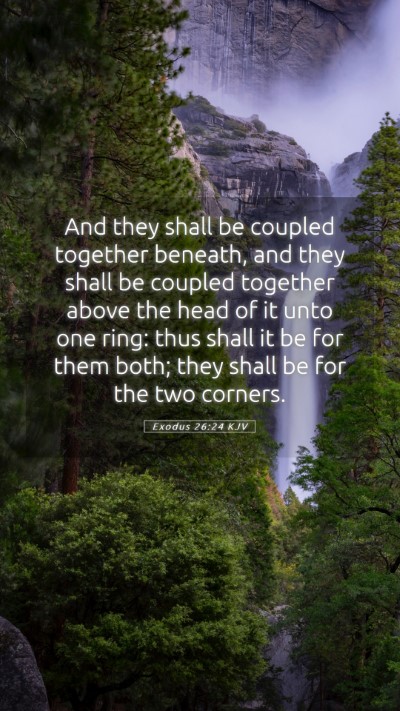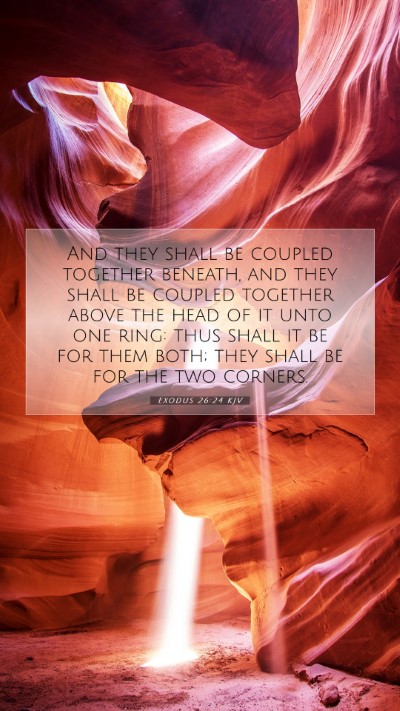Exodus 26:24 - Bible Verse Meanings and Interpretations
Understanding Exodus 26:24 requires a deep dive into its context within the Scriptures. This verse discusses the construction of the Tabernacle, a significant location for worship in the Israelite tradition. Below, we explore a comprehensive interpretation using insights gathered from public domain commentaries by Matthew Henry, Albert Barnes, and Adam Clarke.
Verse Text
"And they shall be joined together at the bottom, and they shall be joined together at the top.” (Exodus 26:24)
Understanding the Context
Exodus 26 describes the construction details of the Tabernacle, which served as a mobile dwelling place for God's presence among His people during their wanderings in the wilderness. This part of the chapter focuses on the curtains of the Tabernacle, symbolizing God's dwelling and holiness among Israel.
Commentary and Analysis
-
Matthew Henry's Commentary
Matthew Henry emphasizes the significance of the structure of the Tabernacle, suggesting that it represents God's intimate relationship with His people. The joining of the curtains at the bottom and top signifies unity and stability in God's presence during the journey of the Israelites. He underscores the meticulous nature of God's instructions, illustrating God's desire for order and beauty in worship.
-
Albert Barnes' Notes
Barnes highlights that the craftsmanship involved in constructing the Tabernacle was a direct reflection of God's majesty and holiness. He explains that the curtains being closely knit or joined serves as a metaphor for the bond between God and His people. The imagery suggests protection and a sacred space set apart for worship and communion with God. Barnes further delves into the practical aspects of the Tabernacle, emphasizing its role as a focal point for religious life.
-
Adam Clarke's Commentary
Clarke notes that the method of joining the curtains together indicates the importance of community and collective worship among the Israelites. The structural integrity symbolizes the strength of their relationship with God. Clarke draws parallels to the New Testament church, illustrating how believers are brought together in Christ, creating a unified body of worshipers. His insights remind us of the continuity between Old and New Testament worship practices.
Application of the Verse
The teachings from Exodus 26:24 can be applied to modern believers in various ways:
- Unity in Worship: Like the curtains of the Tabernacle, believers today are called to come together in unity when worshiping God. This reflects the body of Christ, where each member plays a vital role in the community of faith.
- God's Presence: The verse serves as a reminder of the importance of inviting God's presence into worship, ensuring that our gatherings are filled with reverence and purpose, similar to the sacredness of the Tabernacle.
- Attention to Detail: The specific instructions God provided for the Tabernacle's construction remind us that details matter in our relationship with God. Striving for excellence in our worship practices is essential for honoring Him.
Related Bible Cross References
- Exodus 25:8-9 - Instructions for building the Tabernacle
- Hebrews 9:24 - Connection between the earthly and heavenly sanctuaries
- 1 Corinthians 3:16 - The body of believers as the temple of God
Conclusion
Exodus 26:24 serves as a profound reminder of the sanctity of worship and the importance of community among believers. By reflecting on the insights from public domain commentators like Matthew Henry, Albert Barnes, and Adam Clarke, we gain a richer understanding of Scripture that enhances our worship experience and deepens our relationship with God.
For those seeking more in-depth Bible study insights, interpretations, and explanations, exploring public domain commentaries can provide invaluable resources and perspectives that enrich our understanding of the Bible. Whether through online Bible study groups or individual study, delving into the meanings of Scripture can lead to transformative experiences in our spiritual journey.


